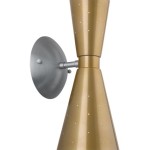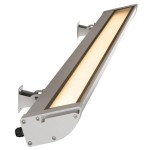Understanding Outdoor Lamp Post PIR (Passive Infrared) Sensors
Outdoor lamp posts equipped with Passive Infrared (PIR) sensors have become increasingly popular for residential, commercial, and public spaces. These motion-activated lighting systems offer a blend of security, energy efficiency, and convenience. Understanding how PIR sensors function, their benefits, and the factors to consider when selecting and installing them is essential for maximizing their potential.
A PIR sensor detects infrared radiation, which is naturally emitted by living things due to their body heat. All objects with a temperature above absolute zero (-273.15°C or 0 K) radiate heat energy. PIR sensors are designed to detect changes in this infrared radiation within their field of view. When a warm object, such as a person or animal, moves into the sensor's range, the sensor detects a rapid change in infrared radiation. This change triggers the connected lamp post to illuminate. The sensitivity and range of the sensor, along with the duration of illumination, are typically adjustable, allowing for customization based on specific needs and environmental conditions.
The core component of a PIR sensor is a pyroelectric sensor, made of a material that generates an electrical charge when exposed to infrared radiation. The sensor typically contains two or more pyroelectric elements arranged in a differential configuration. This arrangement allows the sensor to ignore uniform changes in infrared radiation across its field of view, such as those caused by fluctuations in ambient temperature. Only when a warm object moves from one element's field of view to another does the sensor generate a significant electrical signal, indicating motion. A Fresnel lens is often placed in front of the pyroelectric sensor to focus infrared radiation onto the sensor elements, increasing its sensitivity and detection range. The lens divides the sensor's field of view into multiple zones, further enhancing its ability to detect movement accurately.
Benefits of Outdoor Lamp Post PIR Sensors
Outdoor lamp post PIR sensors offer a multitude of advantages, making them a valuable addition to any property.
Enhanced Security: One of the primary benefits is enhanced security. The sudden illumination of the lamp post when motion is detected acts as a deterrent to potential intruders. The bright light can startle individuals who may be lurking in the shadows, discouraging them from approaching the property. Furthermore, the light provides improved visibility, allowing residents or security personnel to identify and respond to any suspicious activity. The combination of deterrence and visibility significantly contributes to a safer environment.
Energy Efficiency: PIR sensors contribute significantly to energy conservation. Traditional outdoor lights often remain illuminated throughout the night, consuming substantial amounts of electricity. In contrast, PIR-activated lamp posts illuminate only when motion is detected, reducing overall energy consumption by as much as 80-90%. This translates into significant savings on electricity bills, particularly in areas where outdoor lighting is required for extended periods.
Cost Savings: The reduction in energy consumption directly correlates to cost savings. By only activating when needed, the lamp post utilizes less electricity, lowering monthly energy bills. Additionally, the extended lifespan of the light bulb or LED fixture is prolonged, as it is not constantly in use. This reduces the frequency of bulb replacements, further contributing to cost savings over the lifespan of the lighting system.
Convenience: The automatic activation of the lamp post provides convenience for residents and visitors. There is no need to manually switch on lights when approaching the property at night. The lights automatically illuminate, providing a safe and well-lit pathway. This is particularly beneficial for individuals carrying groceries, walking pets, or navigating uneven terrain.
Extended Bulb Lifespan: Since the light is only on when needed, the bulb’s lifespan is extended. Constant use significantly reduces the lifespan of traditional bulbs. By utilizing a PIR sensor, the activation periods are far less frequent, resulting in much longer periods before replacement is needed.
Factors to Consider When Choosing an Outdoor Lamp Post PIR Sensor
Selecting the right outdoor lamp post PIR sensor requires careful consideration of several factors to ensure optimal performance and reliability.
Detection Range and Angle: The detection range and angle of the sensor are crucial parameters that determine the area covered by the motion detection system. A wider detection angle allows the sensor to detect motion from a broader area, while a longer detection range enables it to detect motion from a greater distance. Consider the size of the area that needs to be monitored and select a sensor with appropriate range and angle characteristics. Adjustable sensors offer greater flexibility, allowing for fine-tuning to match specific requirements.
Sensitivity Adjustment: The sensitivity of the PIR sensor determines how easily it is triggered by motion. High sensitivity settings may result in frequent activations due to small animals, wind-blown vegetation, or moving shadows. Conversely, low sensitivity settings may cause the sensor to miss genuine motion events. Adjustable sensitivity settings are essential for fine-tuning the sensor to the specific environment, minimizing false alarms while ensuring reliable detection of actual motion. Calibration is important to achieve correct sensitivity after installation.
Light Duration Settings: The light duration setting determines how long the lamp post remains illuminated after motion is detected. Short durations conserve energy, while longer durations provide extended illumination for enhanced visibility. Adjustable light duration settings allow for customization based on individual preferences and security needs. The setting should be long enough to address the necessary need for illumination, but not so long that the light stays on excessively, wasting energy.
Weather Resistance: Outdoor lamp posts are exposed to various weather conditions, including rain, snow, wind, and extreme temperatures. It is essential to select a PIR sensor that is specifically designed for outdoor use and has a high degree of weather resistance. Look for sensors with an IP (Ingress Protection) rating of IP65 or higher, indicating protection against dust and water ingress. Durable construction and weatherproof enclosures ensure reliable performance in harsh environmental conditions.
Power Source: PIR sensor lamp posts can be powered either by mains electricity or by batteries. Mains-powered systems offer a continuous and reliable power supply, while battery-powered systems provide greater flexibility in terms of installation location. Battery-powered systems require periodic battery replacements, while mains-powered systems may require professional installation. Evaluate the pros and cons of each power source and select the option that best suits your needs and circumstances. Solar powered options are also available. These require no external power source and rely entirely on light from the sun for energy collection.
Installation and Maintenance of Outdoor Lamp Post PIR Sensors
Proper installation and regular maintenance are essential for ensuring the long-term performance and reliability of outdoor lamp post PIR sensors.
Installation Location: The installation location significantly impacts the effectiveness of the PIR sensor. Avoid placing the sensor in areas where it may be exposed to direct sunlight, high winds, or reflective surfaces, as these can trigger false alarms. Mount the sensor at an appropriate height and angle to optimize the detection range and minimize false triggers. Ensure that the sensor has a clear line of sight to the area that needs to be monitored. Obstructions, such as trees or bushes, can limit the sensor's field of view and reduce its effectiveness.
Wiring and Connections: Ensure that all wiring and connections are properly insulated and protected from the elements. Use appropriate weatherproof connectors and conduits to prevent water ingress and corrosion. Follow all local electrical codes and regulations when installing the lamp post and connecting the PIR sensor. If you are not comfortable working with electrical wiring, it is recommended to hire a qualified electrician to perform the installation.
Testing and Calibration: After installation, thoroughly test the PIR sensor to ensure that it is functioning correctly. Walk through the detection area and verify that the lamp post illuminates as expected. Adjust the sensitivity, light duration, and other settings as needed to optimize performance. Regularly calibrate the sensor to account for changes in the environment, such as seasonal changes in foliage or the addition of new obstacles.
Regular Cleaning: Periodically clean the lens of the PIR sensor to remove any dust, dirt, or debris that may accumulate over time. Use a soft, damp cloth to gently wipe the lens. Avoid using abrasive cleaners or solvents, as these can damage the lens and impair its performance. Regular cleaning ensures that the sensor maintains its sensitivity and accuracy.
Battery Replacement (if applicable): For battery-powered systems, regularly check the battery level and replace the batteries as needed. Low battery power can affect the sensor's performance and reduce its detection range. Use high-quality batteries with a long lifespan to minimize the frequency of battery replacements. Consider using rechargeable batteries to reduce environmental impact and long-term costs.
By considering these factors and implementing proper installation and maintenance practices, outdoor lamp post PIR sensors can provide years of reliable security, energy efficiency, and convenience.

A Guide To Pir Sensors

Konstsmide 7249 759 Milano Medium Single Light Garden Post In Black Silver Finish With Pir Sensor 27813 Outdoor Lighting From Castlegate Lights

Konstsmide Milano Outdoor Post Light With Pir Sensor Lighting Direct

Victorian Lantern Lamp Post Pir Motion Sensor Fitment

Konstsmide 7249 759 Milano Medium Single Light Garden Post In Black Silver Finish With Pir Sensor 27813 Outdoor Lighting From Castlegate Lights

Solar Gate Post Light With Pir Motion Sensor Solamon Led Range

A Guide To Pir Sensors

Outsunny 77 Solar Lamp Post Light Waterproof Aluminum Outdoor Vintage Street Motion Activated Sensor Pir Adjustable Brightness For Garden Lawn Pathway Driveway Black Com

Pir Led Bollard Garden Lamp Post Stainless Steel Outdoor Motion Sensor Light

Outsunny 8 Solar Lamp Post Light Waterproof Aluminum Motion Activated Sensor Pir Automatic Outdoor Vintage Street For Garden Lawn Pathway Driveway Black Com
Related Posts







